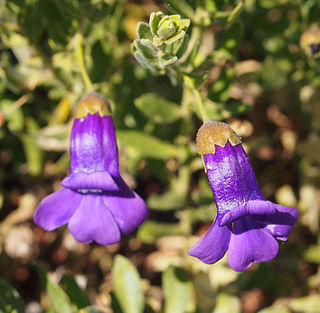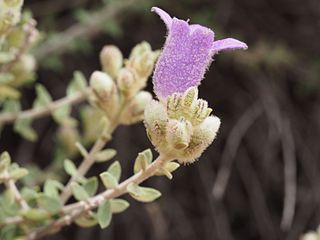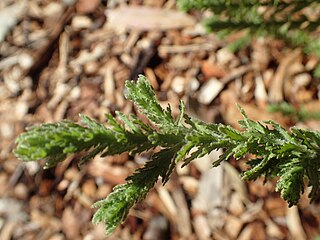
Eremophila hygrophana is a flowering plant in the figwort family, Scrophulariaceae and is endemic to Australia. It is an erect, compact shrub with crowded, grey leaves and violet to purple flowers and is native to South Australia and Western Australia.

Eremophila macdonnellii, also known as MacDonnell's desert fuchsia, is a flowering plant in the figwort family, Scrophulariaceae and is endemic to Australia. It is a shrub with many tangled branches, which, along with the leaves, are often covered with many, sometimes long hairs. The flowers are deep violet or purple, and the species is widespread in Central Australia.

Eremophila homoplastica is a flowering plant in the figwort family, Scrophulariaceae and is endemic to Western Australia. It is a small shrub with many fine, tangled branches, tiny leaves and purple to lilac-coloured flowers.

Eremophila ionantha is a flowering plant in the figwort family, Scrophulariaceae and is endemic to Western Australia. It is a shrub with many sticky branches, narrow, light green leaves and blue, purple or violet flowers.

Eremophila lachnocalyx, commonly known as woolly-sepaled eremophila, is a flowering plant in the figwort family, Scrophulariaceae and is endemic to Western Australia. It is an erect, spreading shrub with densely hairy, greyish leaves but its most distinctive feature is its densely woolly sepals.

Eremophila malacoides, commonly known as frontage poverty bush, is a flowering plant in the figwort family, Scrophulariaceae and is endemic to Western Australia. It is a shrub with grey-green foliage, densely hairy leaves, and usually lilac to purple flowers but a yellow flowered form also occurs.
Eremophila metallicorum, commonly known as miners poverty bush, is a flowering plant in the figwort family, Scrophulariaceae and is endemic to Western Australia. It is a small shrub with narrow leaves and lilac-coloured flowers on an S-shaped stalk.

Eremophila muelleriana, commonly known as round-leaved eremophila, is a flowering plant in the figwort family Scrophulariaceae, and is endemic to Western Australia. It is an open shrub with light-coloured new foliage, broad leaves and deep purple-violet flowers.
Eremophila oblonga is a flowering plant in the figwort family, Scrophulariaceae and is endemic to Western Australia. It is a small, domed-shaped shrub with small, fleshy leaves and purple or mauve flowers growing near Balladonia.
Eremophila pallida is a flowering plant in the figwort family, Scrophulariaceae and is endemic to Western Australia. It is a small, spreading shrub with hairy stems, leaves with a few serrations and reddish purple to violet flowers.
Eremophila perglandulosa is a flowering plant in the figwort family, Scrophulariaceae and is endemic to Western Australia. It is a low, spreading shrub which has small leaves with many glandular hairs and mauve or purple flowers.

Eremophila pinnatifida, commonly known as Dalwallinu eremophila is a flowering plant in the figwort family, Scrophulariaceae and is endemic to Western Australia. It is a spreading, rounded shrub with aromatic, deeply divided leaves and pale purple flowers which are white with purple spots inside. It is a rare plant, known only from a few areas near Perth.
Eremophila pungens is a flowering plant in the figwort family, Scrophulariaceae and is endemic to Australia. It is an erect, sticky shrub with broad, serrated-edged leaves which end in a sharp spine and purple or violet flowers.
Eremophila revoluta is a flowering plant in the figwort family, Scrophulariaceae and is endemic to Western Australia. It is a low, dense shrub with small, hairy leaves, very hairy sepals and mauve or purple petals.

Eremophila rigida is a flowering plant in the figwort family, Scrophulariaceae and is endemic to Western Australia. It is an erect, rigid shrub with thick, hairy, rigid leaves and pale yellowish-cream flowers.

Eremophila rotundifolia is a flowering plant in the figwort family, Scrophulariaceae and is endemic to Australia. It is a shrub with many tangled branches with its leaves and branches covered with a layer of silvery-grey hairs. Its flowers range in colour from pale to deep lilac. It is common in South Australia and there is also a single record from the Northern Territory.
Eremophila shonae is a flowering plant in the figwort family, Scrophulariaceae and is endemic to Western Australia. It is an erect shrub or a low spreading shrub, depending on subspecies and has very sticky branches and leaves due to the presence of large amounts of resin. The leaves are narrow and the flowers are mauve to purple and white inside with purple spots.
Eremophila simulans is a flowering plant in the figwort family, Scrophulariaceae and is endemic to Western Australia. It is an erect shrub with broad, serrated leaves and violet to purple flowers.

Eremophila ternifolia, commonly known as Wongan eremophila is a flowering plant in the figwort family, Scrophulariaceae and is endemic to Western Australia. It is a low, many-branched, shrub with short, pointed leaves and small lilac-coloured or mauve flowers.
Eremophila viscimarginata is a flowering plant in the figwort family, Scrophulariaceae and is endemic to Western Australia. It is a small, erect, prickly shrub with hairy stems, small leaves, greenish-pink sepals and mauve petals.












